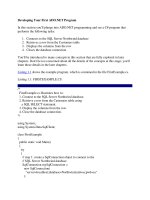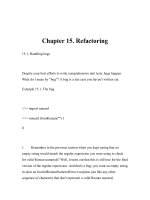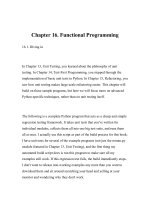Dive Into Python-Chapter 2. Your First Python
Bạn đang xem bản rút gọn của tài liệu. Xem và tải ngay bản đầy đủ của tài liệu tại đây (361.65 KB, 17 trang )
Chapter 2. Your First Python Program
You know how other books go on and on about programming fundamentals
and finally work up to building a complete, working program? Let's skip all
that.
2.1. Diving in
Here is a complete, working Python program.
It probably makes absolutely no sense to you. Don't worry about that,
because you're going to dissect it line by line. But read through it first and
see what, if anything, you can make of it.
Example 2.1. odbchelper.py
If you have not already done so, you can download this and other examples
used in this book.
def buildConnectionString(params):
"""Build a connection string from a dictionary
of parameters.
Returns string."""
return ";".join(["%s=%s" % (k, v) for k, v in
params.items()])
if __name__ == "__main__":
myParams = {"server":"mpilgrim", \
"database":"master", \
"uid":"sa", \
"pwd":"secret" \
}
print buildConnectionString(myParams)
Now run this program and see what happens.
In the ActivePython IDE on Windows, you can run the Python program
you're editing by choosing File->Run... (Ctrl-R). Output is displayed in
the interactive window.
In the Python IDE on Mac OS, you can run a Python program with
Python->Run window... (Cmd-R), but there is an important option you
must set first. Open the .py file in the IDE, pop up the options menu by
clicking the black triangle in the upper-right corner of the window, and
make sure the Run as __main__ option is checked. This is a per-file
setting, but you'll only need to do it once per file.
On UNIX-compatible systems (including Mac OS X), you can run a
Python program from the command line: python odbchelper.py
The output of odbchelper.py will look like this:
server=mpilgrim;uid=sa;database=master;pwd=secret
2.2. Declaring Functions
Python has functions like most other languages, but it does not have separate
header files like C++ or interface/implementation sections like
Pascal. When you need a function, just declare it, like this:
def buildConnectionString(params):
Note that the keyword def starts the function declaration, followed by the
function name, followed by the arguments in parentheses. Multiple
arguments (not shown here) are separated with commas.
Also note that the function doesn't define a return datatype. Python functions
do not specify the datatype of their return value; they don't even specify
whether or not they return a value. In fact, every Python function returns a
value; if the function ever executes a return statement, it will return that
value, otherwise it will return None, the Python null value.
In Visual Basic, functions (that return a value) start with function,
and subroutines (that do not return a value) start with sub. There are no
subroutines in Python. Everything is a function, all functions return a
value (even if it's None), and all functions start with def.
The argument, params, doesn't specify a datatype. In Python, variables are
never explicitly typed. Python figures out what type a variable is and keeps
track of it internally.
In Java, C++, and other statically-typed languages, you must specify the
datatype of the function return value and each function argument. In
Python, you never explicitly specify the datatype of anything. Based on
what value you assign, Python keeps track of the datatype internally.
2.2.1. How Python's Datatypes Compare to Other Programming
Languages
An erudite reader sent me this explanation of how Python compares to other
programming languages:
statically typed language
A language in which types are fixed at compile time. Most statically
typed languages enforce this by requiring you to declare all variables
with their datatypes before using them. Java and C are statically typed
languages.
dynamically typed language
A language in which types are discovered at execution time; the
opposite of statically typed. VBScript and Python are dynamically
typed, because they figure out what type a variable is when you first
assign it a value.
strongly typed language
A language in which types are always enforced. Java and Python are
strongly typed. If you have an integer, you can't treat it like a string
without explicitly converting it.
weakly typed language
A language in which types may be ignored; the opposite of strongly
typed. VBScript is weakly typed. In VBScript, you can concatenate
the string '12' and the integer 3 to get the string '123', then treat
that as the integer 123, all without any explicit conversion.
So Python is both dynamically typed (because it doesn't use explicit datatype
declarations) and strongly typed (because once a variable has a datatype, it
actually matters).
2.3. Documenting Functions
You can document a Python function by giving it a doc string.
Example 2.2. Defining the buildConnectionString Function's doc
string
def buildConnectionString(params):
"""Build a connection string from a dictionary
of parameters.
Returns string."""
Triple quotes signify a multi-line string. Everything between the start and
end quotes is part of a single string, including carriage returns and other
quote characters. You can use them anywhere, but you'll see them most
often used when defining a doc string.
Triple quotes are also an easy way to define a string with both single and
double quotes, like qq/.../ in Perl.
Everything between the triple quotes is the function's doc string, which
documents what the function does. A doc string, if it exists, must be the
first thing defined in a function (that is, the first thing after the colon). You









